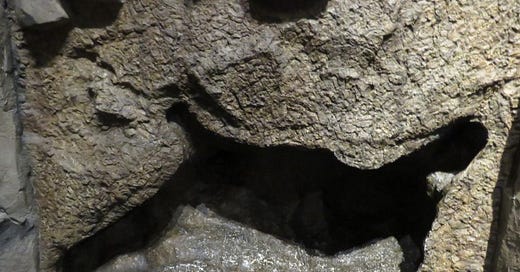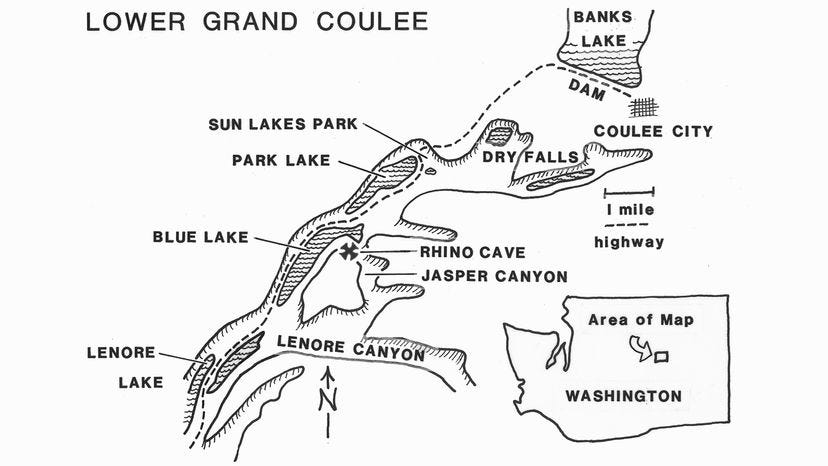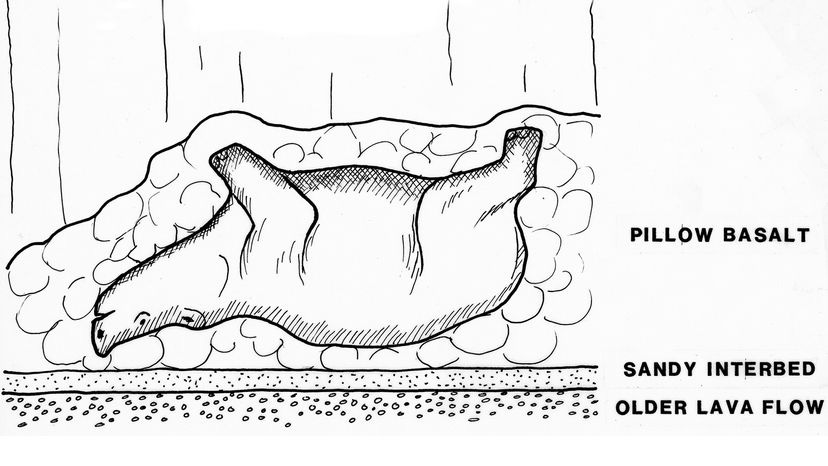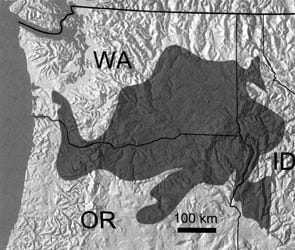CONTENTS
.1. RHINO FOSSIL IN LAVA (RFIL)
.2. COLUMBIA RIVER BASALT GROUP (CRBG)
.3. YOUNGER DRYAS FLOOD
.1. RHINO FOSSIL IN LAVA (RFIL)
There's a Rhino-shaped Cave in Washington State, By Mark Mancini
https://science.howstuffworks.com/environmental/earth/geology/rhino-shaped-cave.htm
One of the strangest fossils ever discovered is actually a cave. About 15 million {I say 4,600} years ago, in eastern Washington state, a volcanic fissure eruption sent lava streaming into a shallow river or lake where a rhino happened to be wallowing.
A layer of basaltic rock formed around the beast, preserving the outline of its (well-cooked) body. For millions {I say thousands} of years, this rhino-shaped hole in the earth lay hidden in the cliffs of Washington's Grant County, near Blue Lake, a popular hiking destination.
By the 1930s, erosion had worn a hole into one end of the subterranean creature mold, exposing it to the open air.
{That's when some hikers found the hole and some bones in the bottom. I think the next image is a cast. Following that is a short video that shows it better.}
The great Grand Coulee and the vast Channeled Scabland, which dissect most of the Columbia Plateau, were probably formed in only a few weeks during the last Ice Age when an ice dam to the northeast was suddenly washed away. COURTESY OF THE BURKE MUSEUM
Paleontologists think the Blue Lake Rhino Cave likely formed around the corpse of a Diceratherium {a two-horned rhino}.
This diagram shows how the rhino was likely exposed by a glacial flood 200 feet (60 meters) above the surface of Blue Lake in Washington. Note the bubble-filled basalt from an earlier lava flow, the light-colored sandy sediments, which were once a lake bottom, and the pillow basalt surrounding the cave. COURTESY OF THE BURKE MUSEUM
The dimensions of the Blue Lake cave tell us that the Diceratherium who left it behind was about 8 feet (2.4 meters) long from snout to rear and stood a little less than 4 feet (1.2 meters) tall at the shoulder. In life, the animal probably weighed 1 ton (0.9 metric tons) or so.
Judging by the contours of the mold, it seems the body was rather bloated. This could indicate that decomposition was already setting in. Also, the legs are pointed skyward, telling us the rhino may have been floating on its back in a state of rigor mortis.
The cave's walls are made of 15-million-year-old {I say 4,600 year-old} pillow basalt, a kind of igneous rock that normally forms when lava contacts cold water and rapidly cools down. So dead or alive, the Diceratherium must've been hanging out in a body of water during a volcanic eruption. Then the lava came pouring in….
The cold water converted the molten rock into a tightly packed layer of hardening pillow basalt. The corpse eventually rotted away and most of its bones disappeared. Yet the mold that enveloped the body stayed largely intact.
.2. COLUMBIA RIVER BASALT GROUP (CRBG)
Field studies in the Columbia River basalt, Northwest USA
https://creation.com/field-studies-in-the-columbia-river-basalt-northwest-usa
Summary. The thick lava flows comprising the Columbia River Basalt Group (CRBG) in the US state of Washington, and adjacent parts of the state of Oregon {& Idaho}, contain a significant number of pillow lavas and palagonites — all indicative of subaqueous extrusion. Individual lava flows invariably show ‘knife-sharp’ contacts between flows, which is consistent with the flows occurring one after the other in rapid succession. ... The observations are consistent with the lava flows being extruded catastrophically, emplaced rapidly and cooled quickly, all during the global Flood recorded in the Bible. Taken together, the features of the Columbia River basalts suggest that they were mostly extruded and emplaced during the Late Abative Phase of the Recessive Stage of the Flood. ... The Columbia River Basalt Group (CRBG) is one of about a dozen very large continental flood basalts {i.e. lava flows} of various geological ages that exist on planet Earth. The CRBG covers an area of 163,700 km2 {averaging over 1 km deep} in {much of south}eastern Washington, {and a little of} northern Oregon and ... western Idaho.... The group is composed of about 300 flows, some with volumes as high as 2,000 km3 {or 480 cubic miles, each flow averaging a few meters thick}. A few of the flows advanced up to 750 km.
Regarding the source of the lava flows, Bing A.I. says as follows.
The source of these eruptions was a series of long fissures along the Washington-Oregon-Idaho border, where magma from a mantle plume rose to the surface. The lava flows crossed the Cascade Range and reached the Pacific Ocean, forming thick layers of basalt rock.
.3. YOUNGER DRYAS FLOOD
Part 1 above, RFIL, and part 2, CRBG, are obviously describing the same location. RFIL (Rhino Fossil in Lava) shows that the rhino cavity is in the side of a cliff 200 feet above the present lake surface. This suggests that over 200 feet of sediment was washed away from the area next to the cliff. The CRBG article suggests that these lava flows occurred late during the Great Flood, but rhinos and other large mammals are not found in Great Flood rock strata. That article was written by creationists, who don’t seem to admit that there was another great Flood after Noah’s Flood. The RFIL section mentioned that a glacial flood exposed the rhino fossil. This would mean that a big Flood occurred during the Ice Age. And that’s what many Younger Dryas scholars, like Randall Carlson, claim, which Flooding was due to impacts on the ice sheet, maybe along with volcanism etc. So that’s my tentative conclusion.






